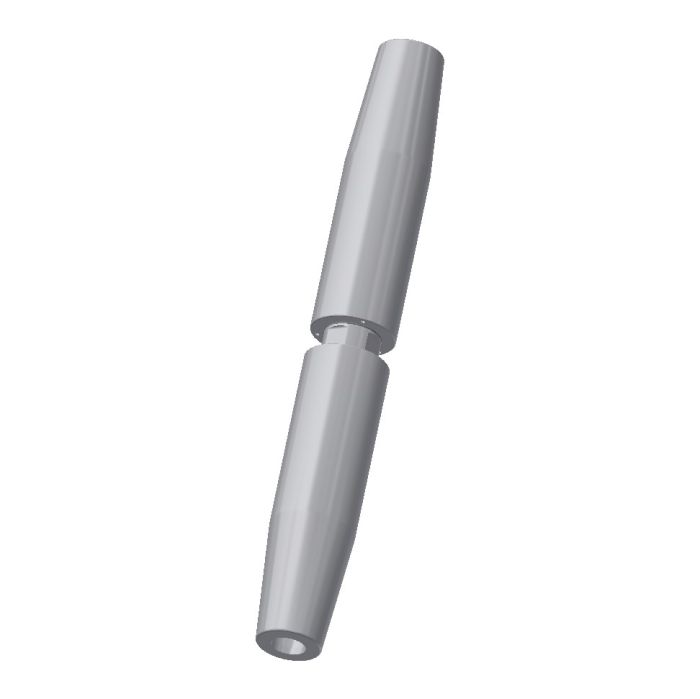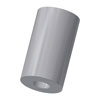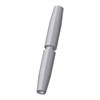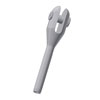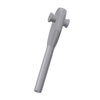High Performance Steel Fixed Socket
The fixed sockets made of high performance steel are including cast steel parts or machined steel components. They can be also classified as swaged or poured sockets. In the company product range MAC and MCC are the two fixed swaged sockets while the poured sockets are TTF, CYF and CYC.
Our range of high-performance steel cables can be either supplied using Full Locked Coil (FLC) ropes or Open Spiral Strands (OSS). Both solutions are available with poured spelter cone type sockets (resin or zinc filled) or with pressed swaged sockets depending on the cable diameter and the project requirements and specifications.
Each socket is made using high strength steels and can be chosen from a wide range of socket shape options, the majority of which are available in either a fixed or length adjustable configuration to meet the design and architectural requirements.
In case of special architectural structural requirements, sockets can be customized in relation to degree of length adjustment, resistance, structural interface.
Cables are terminated to the sockets by means of three possible methods:
- Spelter socketing by poured polyester resin for structural use with minimum 100% efficiency to the strand minimum breaking force. In accordance with EN 13411-4.
- Spelter socketing by poured hot zinc or zinc alloy with minimum 100% efficiency to the strand minimum breaking force. In accordance with EN 13411-4.
- Swaged (pressed) socketing with minimum 90% efficiency to the strand minimum breaking force. In accordance with EN 13411-8.
Spelter socketing involves the following manufacturing operations:
- The wires at the strand end are opened to form a “brush”.
- The brush is ultrasonically cleaned.
- The brush is positioned inside the internal cone profile of the socket.
- Structural polyester resin or zinc / zinc alloy is poured into the socket wires to form socket cone.
- The solid cone that is created transfers the load between cable and socket.
There are no mechanical wedges, grips, serrations, or connections used in the socketing process, meaning there is no mechanical damaging of the wires within the strands at this safety critical area. Whilst the structural efficiency of resin and zinc / zinc alloy socketing is the same, there are some differences to be considered in the selection of the preferred method:
- Resin is cold process and zinc / zinc alloy is a molten hot metal pour, meaning pouring resin is inherently safer than pouring zinc / zinc alloy.
- Resin is more efficient to produce because of the relative curing time compared to zinc / zinc alloy.
- • Zinc / zinc alloy is poured at a temperature of approximately 450 °C, therefore sockets must be pre-heated before socketing operations begin.
- Where there is a requirement for painted sockets, pre-heating the sockets is not possible, therefore resin socketing is the only available choice.
- Resin is recommended for HDPE sheathed cables because of the high temperatures of the poured zinc / zinc alloy can melt and damage the polyethylene.
Socketing by swaging is performed by pressing the section of sockets with the cable termination inside. This method reduces the cable system’s resistance by 10% of strand minimum breaking force. All sockets’ connections are designed to have a breaking force higher than that of the respective strand.
Fix Fork Socket TTF
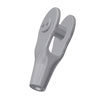
MATERIAL: High strength steel casting G24 Mn6 (EN 10340), BT1 (BS 3100) or G18 NiMoCr3-6 (EN 10340) quenched and tempered
CORROSION PROTECTION: Hot dip galvanising with minimum 85 μm thickness (EN 1461)
NDT EXAMINATION:
• Ultrasonic Test (EN 12680-1)
• Magnetoscopic Test (EN 1369)
• Visual Inspection (EN 1370)
• Dimensional Control (ISO 8062-3)
• Radiographic Examination (EN 12681) upon request
Pin for TTF
MATERIAL: High strength alloy steel CrNiMo (EN ISO 683), rolled or forged, quenched and tempered.
CORROSION PROTECTION: Hot dip galvanising with minimum 85 μm thickness (EN 1461)
NDT EXANINATION: • Ultrasonic Test (EN 10308)
• Dimensional Control (EN 22768-2 for machining, ISO 965-1 for threads)
Lock plates for TTF
MATERIAL: S355J2 (EN 10025)
CORROSION PROTECTION: Hot dip galvanising with minimum 85 μm thickness (EN 1461)
Cylindrical sockets type CYF
MATERIAL: High strength alloy steel CrNiMo (EN ISO 683), rolled or forged, quenched and tempered.
CORROSION PROTECTION: Hot dip galvanising with minimum 85 μm thickness (EN 1461)
NDT EXAMINATION:
• Ultrasonic Test (EN 10308)
• Dimensional Control (EN 22768-2 for machining, ISO 965-1 for threads)
Cylindrical sockets type CYC
MATERIAL: High strength alloy steel CrNiMo (EN ISO 683), rolled or forged, quenched and tempered.
CORROSION PROTECTION: Hot dip galvanising with minimum 85 μm thickness (EN 1461)
NDT EXAMINATION:
• Ultrasonic Test (EN 10308)
• Dimensional Control (EN 22768-2 for machining, ISO 965-1 for threads)
Coupler for sockets type CYC
MATERIAL: High strength alloy steel 42CrMo4 (EN ISO 683), B7 (ASTM A193) or 2H (ASTM A194)
CORROSION PROTECTION: Hot dip galvanising with bright threads/Geomet
NDT EXAMINATION:
• Ultrasonic Test (EN 10308)
• Magnetoscopic Test (EN 10228-1) only on nuts
• Visual Examination
• Dimensional Control (EN 22768-2 for machining, ISO 965-1 for threads)
Swaged Sockets type MAC
MATERIAL: S355J2 (EN 10025)
CORROSION PROTECTION: Hot dip galvanising (centrifuged) with minimum 55 μm thickness (EN 1461)
NDT EXAMINATION:
• Ultrasonic Test (EN 10308)
• Visual and Dimensional Inspection
Pin for MAC
MATERIAL: High strength alloy steel CrNiMo (EN ISO 683), rolled or forged, quenched and tempered.
CORROSION PROTECTION: Hot dip galvanising with minimum 85 μm thickness (EN 1461)
NDT EXAMINATION:
• Ultrasonic Test (EN 10308)
• Dimensional Control (EN 22768-2 for machining, ISO 965-1 for threads)
Swaged Sockets type MCC
MATERIAL: S355J2 (EN 10025)
CORROSION PROTECTION: Hot dip galvanising (centrifuged) with minimum 55 μm thickness (EN 1461)
NDT EXAMINATION:
• Ultrasonic Test (EN 10308)
• Visual and Dimensional Inspection
Pin for MCC swaged socket
MATERIAL: High strength alloy steel CrNiMo (EN ISO 683), rolled or forged, quenched and tempered.
CORROSION PROTECTION: Hot dip galvanising with minimum 85 μm thickness (EN 1461)
NDT EXAMINATION:
• Ultrasonic Test (EN 10308)
• Dimensional Control (EN 22768-2 for machining, ISO 965-1 for threads)
Swaged Sockets type MAC
MATERIAL: 42CrMo4 (EN ISO 683)
PROTECTION: Hot dip galvanising (centrifuged) with minimum 55 μm thickness (EN 1461)
NDT EXAMINATION:• Ultrasonic Test (EN 10308)• Visual and Dimensional Inspection
Pin for MAC
MATERIAL: High strength alloy steel CrNiMo (EN ISO 683), rolled or forged, quenched and tempered.
CORROSION PROTECTION: Hot dip galvanising with minimum 85 μm thickness (EN 1461)
NDT EXAMINATION:
• Ultrasonic Test (EN 10308)
• Dimensional Control (EN 22768-2 for machining, ISO 965-1 for threads)
Swaged Sockets type MCC
MATERIAL: 42CrMo4 (EN ISO 683)
CORROSION PROTECTION: Hot dip galvanising (centrifuged) with minimum 55 μm thickness (EN 1461)
NDT EXAMINATION:
• Ultrasonic Test (EN 10308)
• Visual and Dimensional Inspection
Pin for MCC swaged socket
MATERIAL: High strength alloy steel CrNiMo (EN ISO 683), rolled or forged, quenched and tempered.
CORROSION PROTECTION: Hot dip galvanising with minimum 85 μm thickness (EN 1461)
NDT EXAMINATION:
• Ultrasonic Test (EN 10308)
• Dimensional Control (EN 22768-2 for machining, ISO 965-1 for threads)
|
|
MATERIAL |
CORROSION PROTECTION |
NDT EXAMINATION |
|
Fix Fork Socket TTF Adjustable Fork Socket TBF Socket Body for Bridge Socket BRC |
High strength steel casting G24 Mn6 (EN 10340), BT1 (BS 3100) or G18 NiMoCr3-6 (EN 10340) quenched and tempered |
Hot dip galvanising with minimum 85 μm thickness (EN 1461) |
• Ultrasonic Test (EN 12680-1) • Magnetoscopic Test (EN 1369) • Visual Inspection (EN 1370) • Dimensional Control (ISO 8062-3) • Radiographic Examination (EN 12681) upon request |
|
Socket body for TBF Cylindrical sockets type CYF, CYT, CYN, CYW, CYB, CYR, CYV, CYM, CYC and CYA Pin for TTF socket, TBF socket Pin for BRC socket Pin for MAC, MAC-R, TBC, MCC swaged socket Bush for CYB, CYR Nuts for CYT, CYN, CYW |
High strength alloy steel CrNiMo (EN ISO 683), rolled or forged, quenched and tempered. |
Hot dip galvanising with minimum 85 μm thickness (EN 1461) |
• Ultrasonic Test (EN 10308) • Dimensional Control (EN 22768-2 for machining, ISO 965-1 for threads) |
|
Threaded rods and nuts for sockets type CYB, CYR, CYV, CYM and BRC Coupler for sockets type TBF, CYC and CYA |
High strength alloy steel 42CrMo4 (EN ISO 683), B7 (ASTM A193) or 2H (ASTM A194) |
Hot dip galvanising with bright threads/Geomet |
• Ultrasonic Test (EN 10308) • Magnetoscopic Test (EN 10228-1) only on nuts • Visual Examination • Dimensional Control (EN 22768-2 for machining, ISO 965-1 for threads) |
|
Lock plates for TTF/TBF socket pin Washers for CYW, CYR, CYV |
S355J2 (EN 10025) |
Hot dip galvanising with minimum 85 μm thickness (EN 1461) |
|
|
Swaged Sockets type MAC, MAC-R, MCC, TBC and FLT |
42CrMo4 (EN ISO 683) or S355J2 (EN 10025) |
Hot dip galvanising (centrifuged) with minimum 55 μm thickness (EN 1461) |
• Ultrasonic Test (EN 10308) • Visual and Dimensional Inspection |
- CYS - Adjustable Sockets - High Performance Steel Cable System (1.11 MB)
- CYC - Fix Sockets - High Performance Steel Cable System (1.04 MB)
- CYF - Fix Sockets - High Performance Steel Cable System (1.11 MB)
- MAC S355J2 - Fix Sockets - High Performance Steel Cable System (0.87 MB)
- MAC 42CrMo4 - Fix Sockets - High Performance Steel Cable System (0.84 MB)
- MCC S355J2 - Fix Sockets - High Performance Steel Cable System (0.83 MB)
- MCC 42CrMo4 - Fix Sockets - High Performance Steel Cable System (0.83 MB)
- TTF - Fix Sockets - High Performance Steel Cable System (1.37 MB)
- CYC 2D (5.45 MB)
- CYC 3D (5.49 MB)
- CYF 2D (5.16 MB)
- CYF 3D (2.5 MB)
- MAC S355J2 2D (2.73 MB)
- MAC S355J2 3D (0.68 MB)
- MAC 42CrMo4 2D (2.93 MB)
- MAC 42CrMo4 3D (0.66 MB)
- MCC S335J2 2D (2.6 MB)
- MCC S335J2 3D (0.75 MB)
- MCC 42CrMo4 2D (2.62 MB)
- MCC 42CrMo4 3D (0.73 MB)
- TTF 2D (7.91 MB)
- TTF 3D (9.34 MB)

